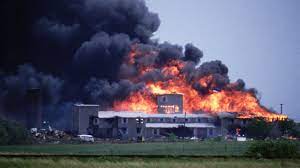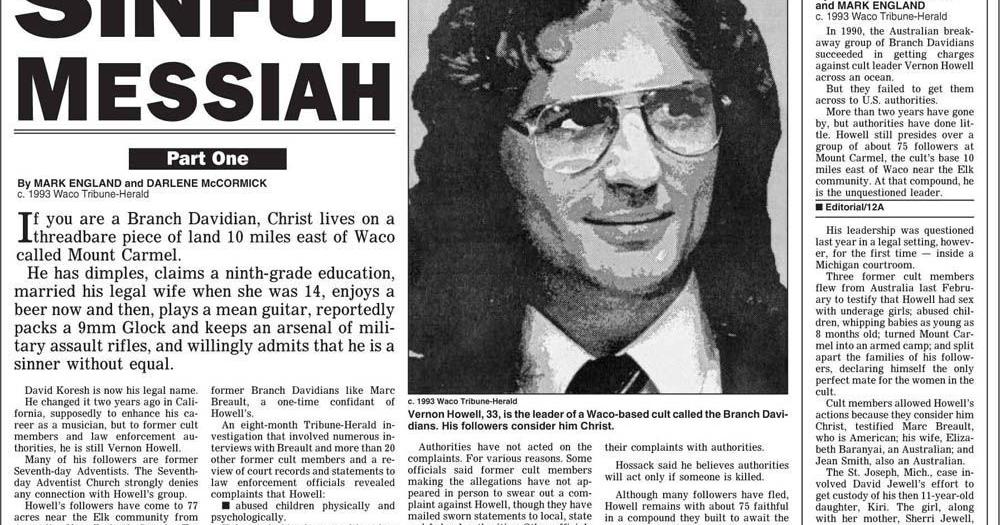The Conflagration at Waco
Why do so many charismatic cult leaders go off the rails? As Lord Acton warned, “absolute power corrupts absolutely.”
This essay originally appeared in Law & Liberty on February 7, 2023 (here). Thanks to Power Line, Instapundit (here), Real Clear Books (here), Real Clear Wire (here), Real Clear Religion (here), and Real Clear History (here)!
It used to be said—accurately, before the Left’s capture of the Fourth Estate—that journalism is “the first rough draft of history.” For those readers of a certain age, our own recollection of events serves the same purpose. I remember well the horrific 1993 showdown between federal law enforcement officers (ATF and FBI) and David Koresh (a/k/a Vernon Wayne Howell) and his followers at the Mount Carmel compound outside Waco in which over 80 persons—including four ATF agents and many children—died. In Rashomon fashion, the events tended to be perceived in different ways, depending on one’s perspective. Which version is true?

Was the protracted siege, which ended in a catastrophic inferno, the fault of a manipulative, child-abusing, polygamous cult leader who prophesied—even provoked—a fatal encounter with the authorities (whom he regarded as the forces of Babylon)? Or was the tragic outcome, which came on the heels of the ATF’s and FBI’s 1992 debacle at Ruby Ridge, due to the poorly-conceived, overly-aggressive, and ineptly-executed tactics of federal authorities acting with the ultimate approval of U.S. Attorney General Janet Reno (appointed by President Bill Clinton)? Oklahoma City bomber Timothy McVeigh was inspired by the events at Waco, and his murderous attack on the OKC federal building—with a death toll of 168, including 19 children—occurred on the second anniversary of the so-called Branch Davidians’ immolation at Mount Carmel.

Texas-based historian Jeff Guinn, in his extensively-researched account of the conflagration, Waco, assigns blame to both sides. Guinn specializes in giving a “deep dive” into figures and events superficially familiar to Americans through contemporaneous news coverage or popular mythology. His previous books have featured Charles Manson, Bonnie and Clyde, and the Jonestown tragedy (in which over 900 people perished, including hundreds of children), among other topics. In Waco, Guinn concludes that the only wholly-innocent victims in this epic disaster were the 23 children consumed in the fire.
What happened at Waco? As Guinn comprehensively and exhaustively explains, the group typically referred to a “Branch Davidians” was a spin-off from the Seventh-day Adventist Church (which in turn was the successor to the Millerite sect established in upstate New York in 1843). In 1930 an SDA adherent named Victor Houteff founded an apocalyptic movement he called “Shepherd’s Rod” which was based on the belief that only 144,000 believers would be saved when the world ended—the Second Advent. In 1935, Houteff purchased 200 acres outside Waco, which he named Mount Carmel, as the headquarters for his movement. Most of his followers were SDA. In the succeeding decades, the movement changed names, and even physical locations, under a series of different leaders. (Houteff died in 1954.)
A small band of followers remained in the Waco area, under the direction of a 65-year-old widow and self-proclaimed prophet named Lois Roden, when, in 1981, a Bible-quoting 21-year-old drifter and aspiring musician named Vernon Howell arrived at Mount Carmel. Howell had discovered his spiritual home, and in Lois Roden, a mentor and lover. Howell was a quick study. After Roden died in 1986, Howell, who had changed his name to “David Koresh” (the Hebrew transliteration for Persian king Cyrus, referred to in Isaiah 45 as a Gentile messiah), prevailed in a violent power struggle with Roden’s erratic son, George. (Foreshadowing the future, the 1987 quarrel escalated into a 45-minute shootout.) Howell/Koresh remained in control until the fateful showdown in 1993.

Guinn argues—convincingly, to my mind—that both Lois Roden and Howell/Koresh were influenced by the writings of a turn-of-the-century charismatic cult leader named Cyrus Teed, who pronounced himself “Koresh,” after the Old Testament prophet Cyrus, and professed to be divinely appointed to receive messages from God and to interpret the cryptic Book of Revelation concerning the conflict that would precede the Second Coming. Teed had organized a utopian community in southwest Florida in the 1890s and, despite his claim of immorality, died in 1908. In 1972, a reissued collection of Teed’s writings, entitled Koreshanity: The New Age Religion, was acquired by the Waco-McLennan County Library—one of the few public libraries to carry the obscure title. While there is no proof that Roden or Howell/Koresh checked out the book, the parallels between Teed’s teachings and those of Roden/Howell/Koresh are striking.
Guinn concludes:
Almost seventy-seven years after the first Koresh’s death, Vernon Wayne Howell, utilizing virtually the same story and many similar details, presented himself to followers as chosen by God to be Cyrus-known-as-Koresh, Lamb of Revelation and opener of the Seven Seals. The parallels defy coincidence. Howell adopted Teed’s prophesies as his own.
Was Howell/Koresh a charlatan, a madman, or a sincere believer who got caught up in the megalomania of cult leadership? No one will ever know for sure, but his approximately 85 followers at Mount Carmel blindly obeyed him—all the way to their doom. The facts of the ATF’s disastrous effort to execute a search warrant and to arrest Howell/Koresh on February 28, 1993, followed by a 51-day showdown with the FBI, are well known, due to the extensive news coverage and the various subsequent investigations, congressional hearings, and reports regarding the fiasco. Guinn summarizes those events thoroughly, but– more importantly–illuminates the nefarious role of the enigmatic Howell/Koresh.
Howell/Koresh was a man of prodigious sexual appetites. In 1984, he married Rachel Jones, the 14-year-old daughter of long-time Branch Davidians. In 1986, even before he assumed control of the Mount Carmel compound, Howell/Koresh announced that God had instructed him to take an additional wife, and he did—the daughter of another follower. Soon the divine instructions were clarified to entail multiple additional wives, including Rachel’s sister. Before long, his divine harem numbered a dozen or more, split between Waco and California. “Sham marriages” with stand-in husbands were orchestrated to protect Howell/Koresh from bigamy or polygamy charges.
He ultimately declared that all married couples in the compound had to surrender their conjugal rights; men (other than himself) must remain celibate and all women became wives of Howell/Koresh, available to him at his whim. The abundance of wives produced a bounty of children. Guinn reports that “at any given time he had several wives in various stages of pregnancy.” Some of his “wives” were as young as 12, and others were barely older: ages 14 and 16. He aimed to impregnate them all. He even made sexual overtures to pre-pubescent girls, some as young as ten. Eventually, 11 different Branch Davidian women bore him a total of 17 children; he prophesied a Biblical command to father 24 offspring. Some wives left prior to the 1993 showdown, taking their children with them. The rest would perish in the conflagration.

Howell/Koresh was as grandiose in his dealings with the law as he was with conventional marriage. The Branch Davidians lived communally and needed to earn money to provide food and other necessities. One income-producing activity instigated by Howell/Koresh was buying and selling second-hand firearms, which included illegally converting semi-automatic rifles to become fully-automatic—in volume. The Branch Davidians also assembled grenades from casings, using black powder to turn the legal hulls into illegal weapons. These less-than-clandestine activities were likely to—and eventually did–bring the isolated, ramshackle compound to the attention of the ATF. (The Branch Davidians were not entrapped, unlike Randy Weaver.)
When the Keystone Kops-like ATF finally procured the search warrant and arrest warrant for multiple federal firearms violations, they had to figure out how to execute them on the remote, heavily-armed compound. Instead of waiting until Howell/Koresh made one of his periodic trips to town, and arresting him away from his devoted followers, the ATF unwisely decided that a “dynamic entry” by a large force of ATF agents—numbering 76–would be effective, provided that they had the element of surprise. As Guinn recounts in depressing detail, the ill-fated mission went forward on the morning of February 28, 1993, despite the ATF’s prior knowledge that the Branch Davidians had learned of the impending raid. The Branch Davidians were well-trained, had an unlimited stock of ammunition, were equipped with automatic weapons and a .50 caliber rifle, and were ready when the ATF agents arrived.
An extended shootout ensued, resulting in the death of four ATF agents and 16 agents wounded. Five Branch Davidians were killed and four (including Howell/Koresh) were wounded. The whole mission was a comedy of errors. No matter who fired first (and the accounts conflict), the results were tragic. However inept the ATF was, engaging in a fire fight with federal agents—with women and children present—borders on “mass suicide by cop.” A cease-fire didn’t end the conflict; the ordeal had just begun.
The FBI took over in the wake of the ATF’s abysmal failure. The FBI brought in tanks, armored vehicles, hundreds of agents, and the Hostage Rescue Team. Despite attempts to negotiate with Howell/Koresh, during which the leader made—and broke—promises to surrender if certain condition were met, the Branch Davidians refused to leave the compound. (A few elderly and children not related to Howell/Koresh were allowed to leave.) The Branch Davidians were convinced that the showdown was a harbinger of the Second Coming; the fulfillment of prophecies about a holy battle with the forces of Babylon; and their painless deliverance to the eternal kingdom.
Even though the building was surrounded, electricity was cut off, fresh water was scarce, and escape was impossible, Howell/Koresh refused to relent. God told him to remain barricaded until he had finished “decoding” or “opening” the Seven Seals, he claimed. His followers believed him.
The FBI became frustrated with what they regarded as Howell/Koresh’s lack of good faith. When the standoff reached 51 days, under the media spotlight, the FBI decided to take more aggressive action. On April 19, with the approval of Attorney General Janet Reno, the FBI began firing nonlethal tear gas canisters into the rickety compound. Still, the Branch Davidians refused to surrender. Tanks breached the walls of the structure, causing a partial structural collapse. Then a fire started, for reasons that remain disputed. In any event, flames quickly consumed the compound, killing most of the occupants. (Some—including Howell/Koresh–took their own lives, and a few escaped.) The final death toll was 76—53 adults and 23 children. Again, no amount of hindsight regarding the FBI’s tactics explains the Branch Davidians’ stubborn refusal to surrender.
The Waco siege was a watershed event during the 1990s. The deadly conflict received sensational media coverage and the final conflagration was vividly captured on video. Americans were horrified, and polarized, by what they saw. Some saw harmless eccentrics burnt alive by an overbearing federal government. Others saw defiant law-breakers, led by a sexual predator, repeatedly refusing to submit to the authority of law enforcement officers, heedless of the certain consequences. Observers tended to see what they wanted to see.
In Waco, Jeff Guinn has written the definitive account of the tragedy, which–while balanced overall–assigns a great deal of the blame to an imperious and reckless cult leader who will forever be remembered as David Koresh. Lord Acton was right: Absolute power corrupts absolutely.

































